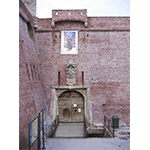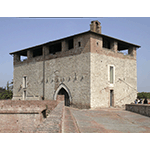Walls and Medici Fortress of Grosseto
The construction of new massive walls around Grosseto as part of the plans to fortify the new borders of the Medici state, was ordered by Cosimo I following the annexation of Siena and Maremma, around the mid 16th century. In particular, the necessity to fortify Grosseto lay in the political and strategic importance of the city, location of a large store of grain and salt, both produced in the area.
Walls already surrounded the city in the Middle Ages, and were rebuilt several times by the Republic of Siena. Around 1540, Anton Maria Lari reinforced the walls of Grosseto with modern angular bastions. Due to the bad conditions of Grosseto’s fortifications after its annexation to the Medici state, the construction of new walls began in 1565 on a project by military architect Baldassarre Lanci and ended around 1593. The walls of Grosseto are hexagonal in shape with bastions at the top. Internally, its perimeter is skirted by a ring-walk, and externally by navigable canals, used during construction also to transport materials. The brick structure responded to the principles of then modern military architecture. The Medici fortification contains several elements of the medieval walls: the Porta Vecchia (old gate) to the south, the only access to the city until 1754 when the Porta Nuova (new gate) was opened to the north, and the Sienese keep (1345), made of squared travertine stones, englobed into the bastion of the Fortress, a massive construction with military functions, made up of barracks, storehouses and a chapel.
The fortification was transformed in 1828 by order of Grand Duke Leopold II of Lorraine, adapting the bulwarks and ramparts into public gardens and lanes, definitively divesting the walls of their military function.
****************************
Texts by Graziano Magrini
English translation by Victor Beard
Last update 27/feb/2008





